The Academy: Practice
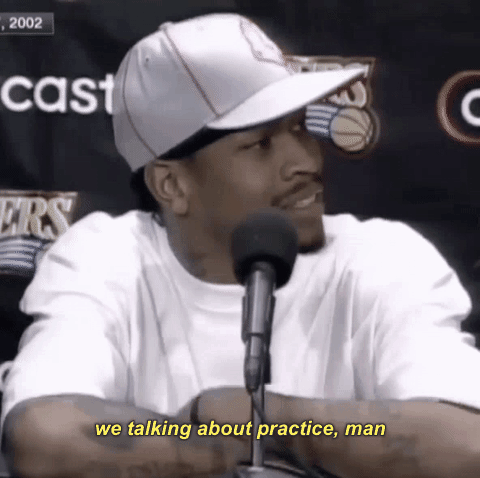
Welcome to The Academy, Cadet! This series will cover the basics you need to mix it up with the Rebel scum/loathsome Resistance/Imperial bucketheads/First Order thugs/spineless bounty hunters/dirty clankers/Jedi filth. Learn your fundamentals well and you just might not end up floating out in the void next to the scorched wreckage of your ship.
One question I see come up pretty often in online spaces is, "how do I practice my X-Wing game?" This week we'll talk about some strategies, both simple and spicy, to sharpen your skills outside of table time at your local game store or the next tournament. I'm a musician by training so efficient and effective practice is something that I have spent a lot of time considering in a professional capacity.
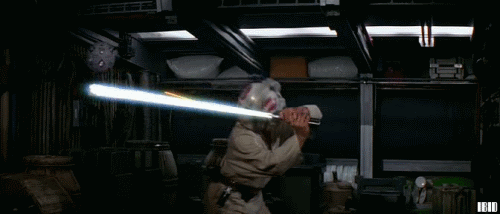
1) Play X-Wing!
Now, this is one I see out there a lot and I personally don't feel it's the best answer. That's why we're going to just get it out of the way first. I know, personally, when I'm looking for practice strategies I want to discuss ways to focus on specific skills and techniques and be able to practice fundamentals efficiently. Practice must be mindful. Still, it's true that one way to get good at X-Wing is to play X-Wing. Playing full games will help you with your list-building and recognizing powerful combinations. It will help you practice remembering your abilities, triggers, and rules interactions once you've settled on a list you like. It will help you react to changing board state and develop tactics to execute your strategy. It isn't exactly in the cards, as it were, for everyone to find an opponent regularly to play or even space to set up your mat at home so luckily there are some workarounds available.
FlyCasual (link)
FlyCasual is essentially an X-Wing "simulator" that lets you play full games against an AI opponent. It's really good for testing squads and opening strategies.
TableTop Simulator (link)
TTS, available on Steam, is another X-Wing simulator that is oriented more toward PvP online play. It more accurately simulates the experience of playing X-Wing in person in that you have to move tokens around and perform other actions instead of the program doing it for you.
Heroes of the Aturi Cluster (link)
HotAC is essentially a multiplayer X-Wing RPG campaign where you play as a squad of Rebel pilots. It can be played in a group or solo and is a nice way to just get some ships on the mat and practice your flying. It's pretty flexible in terms of difficulty, just be aware that some rules will differ from the official game of X-Wing. HotAC and its Imperial counterpart, Flight Group Alpha, are good options for playing X-Wing by yourself if you find yourself unable to locate opponents.
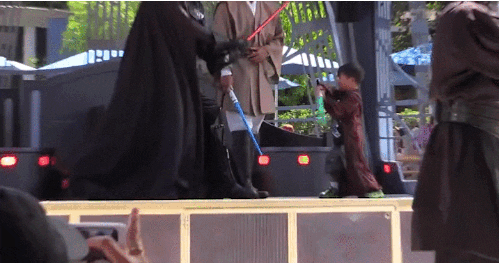
2) Practice Fundamentals and Strategies
The "Guess the Move" Game

This little mini game is one of the most basic ways to practice your maneuvering and one that doesn't even require a mat, much less a full table. Sharpen your ability to judge where a maneuver or reposition action will end by setting your ship on the table, dialing a maneuver, and then placing an equal-sized ship base where you think the ship will end up. Then you lay the template down to execute the maneuver and see how close you got. Pay attention to the relationship between parts of the plastic base from start point to end point. Rinse and repeat! This is a great exercise in X-Wing fundamentals, akin to a musician practicing scales.
Develop a Strong Opening
With the introduction of scenario-based play Turn 0, or setup, strategy has become even more important. You need to have a solid concept of what you want to accomplish in Turns 1 and 2 and know what you need to do to set yourself up to achieve it. A good way to develop this skill is by working backwards. Put the ships in your squad on the mat in the positions you'd like them to be by turn 1,2, or 3, and then maneuver them backwards into positions in your deployment zone. Remember what maneuvers you used and tweak as necessary to get to a solid, repeatable setup that you can remember. Obstacle placement may vary but remember that you always get to place half of them and don't forget that your strategy may change based on the objective.
3) Get Creative!

Any musician or athlete will tell you that rote repetition of fundamentals in practice is not necessarily fun and, beyond a certain point, can produce diminishing returns. Another way to make lessons you learn "stick" more effectively is to vary the format in which the information is presented to your brain. This is like creating mnemonics when you study, a musician changing the rhythm when practicing those scales, or playing a game like HORSE to improve your basketball shot. All this to say: I like to practice by making little games that apply the fundamentals I want to work on. Let's explore one thematic concept I've been playing with.
The Five Sabers
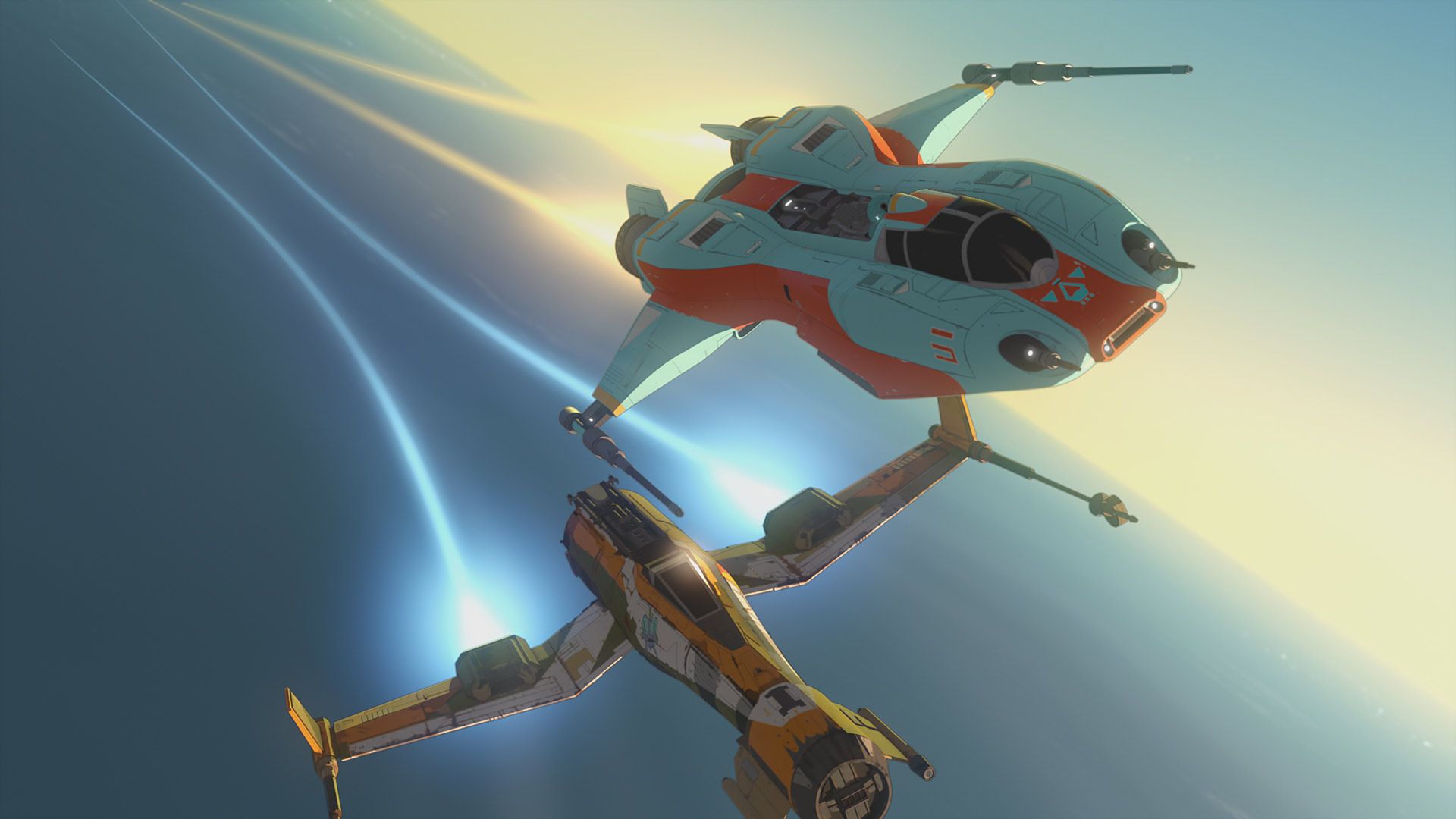
The Five Sabers are, canonically, a series of piloting challenges once supervised by Han Solo that tested a pilot's skills in five different events. Marcus Speedstar, Jarek Yeager's brother, was a three-time Sabers champion and Greer Sonnel of the Resistance participated in the junior division. What a fun, thematic way to practice X-Wing! The challenges will be played by your entire squad working as a Team so you can track your number of moves and/or time and note any improvement. Almost all challenges are run with a Planning Phase (set dials for all ships) and an Activation Phase (execute maneuvers and perform actions in ascending initiative order) just like a regular game of X-Wing.
Event 1: The Atmosperic Dash
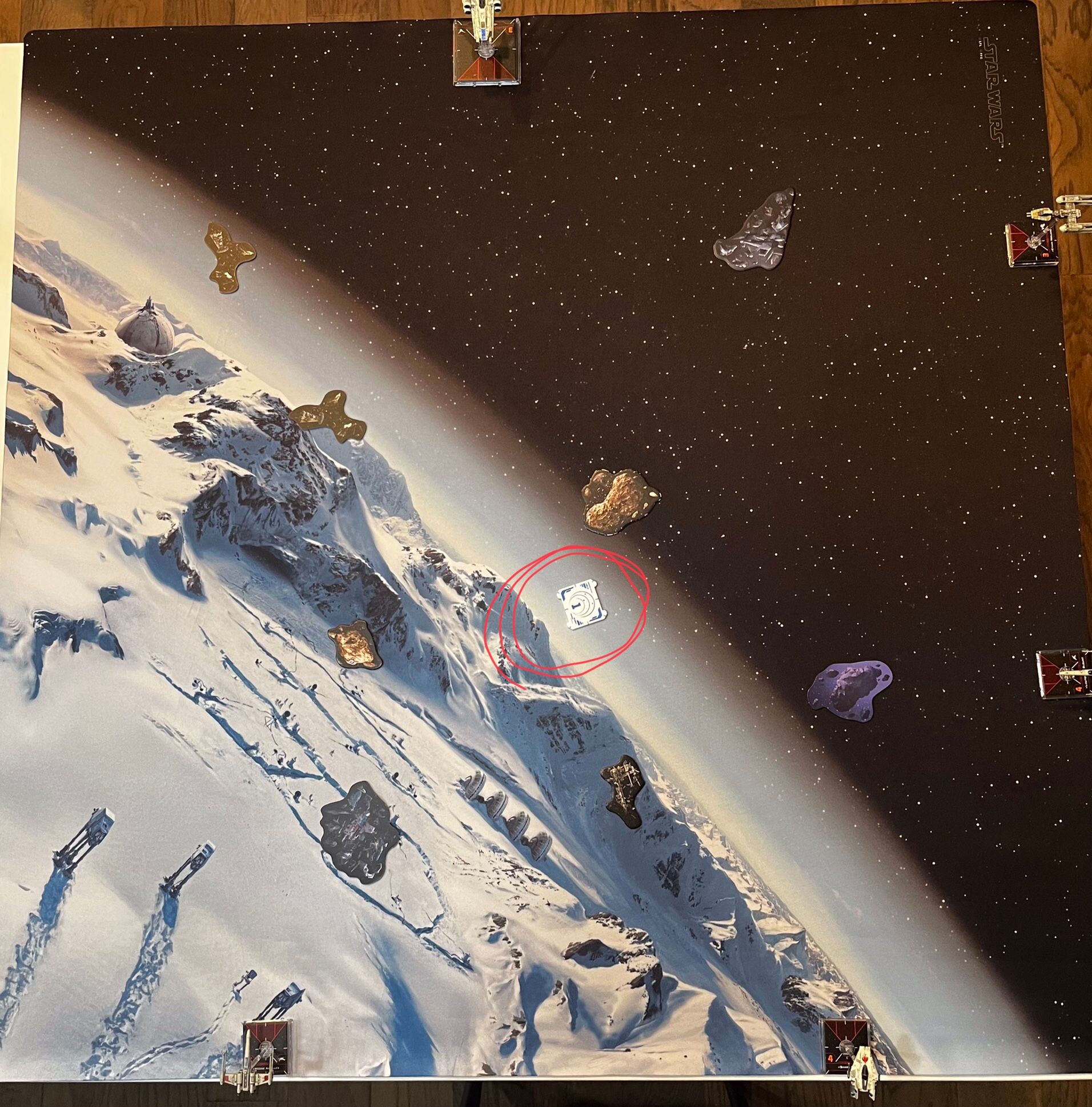
Set up your ships as evenly spaced as possible with all touching the edge of the mat. Set up as many obstacles as you'd like at random. Flip a token (vary type/size based on preferred level of difficulty) into a random position. Fly your ships to try to get them within Range 1 of the target token and then perform a scenario action. The scenario action must be performed as the Perform Action Step (cannot perform if stressed, after repositioning, etc.). Once a ship has done this it has completed the challenge and is removed from the board. Once all of your ships are removed your team has completed this challenge. The goal is to have all ships complete the challenge in as few turns as possible. To increase difficulty if desired:
- change size of target token
- increase number of obstacles
- friendly overlap ionizes or stresses both ships
- change scenario action criteria (token must be in bullseye at Range 1; token must be at Range 0, etc.)
- relocate the target token after a ship completes the challenge
Event 2: The Orbital Sprints
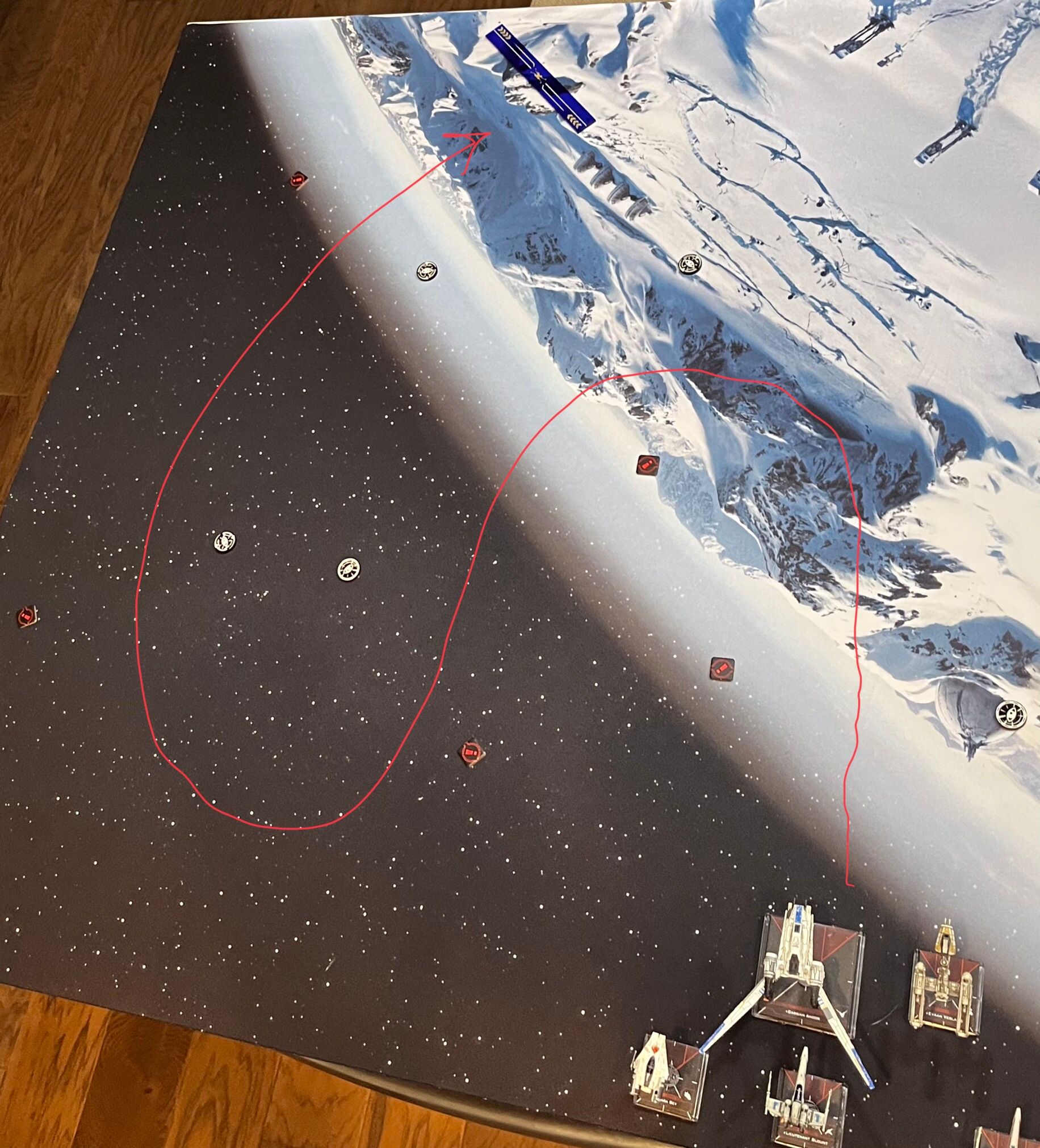
Set up a course of 5 "gates" on the mat using tokens (I like green on the right and red on the left) placed the length of a 4-straight template apart. Set your squad up in a corner. The challenge is to fly your entire squad through the racecourse of gates with each ship flying between each pair of tokens before crossing the finish line. Remember, your entire squad is a Team so pay attention to order of activation to not get in your own way when trying to fit many ships through a small space. The goal is to get all ships through the course in as few turns as possible. To increase difficulty if desired:
- vary size of "gates"
- add obstacles
- friendly overlap ionizes or stresses both ships
Event 3: The Lunar Relays
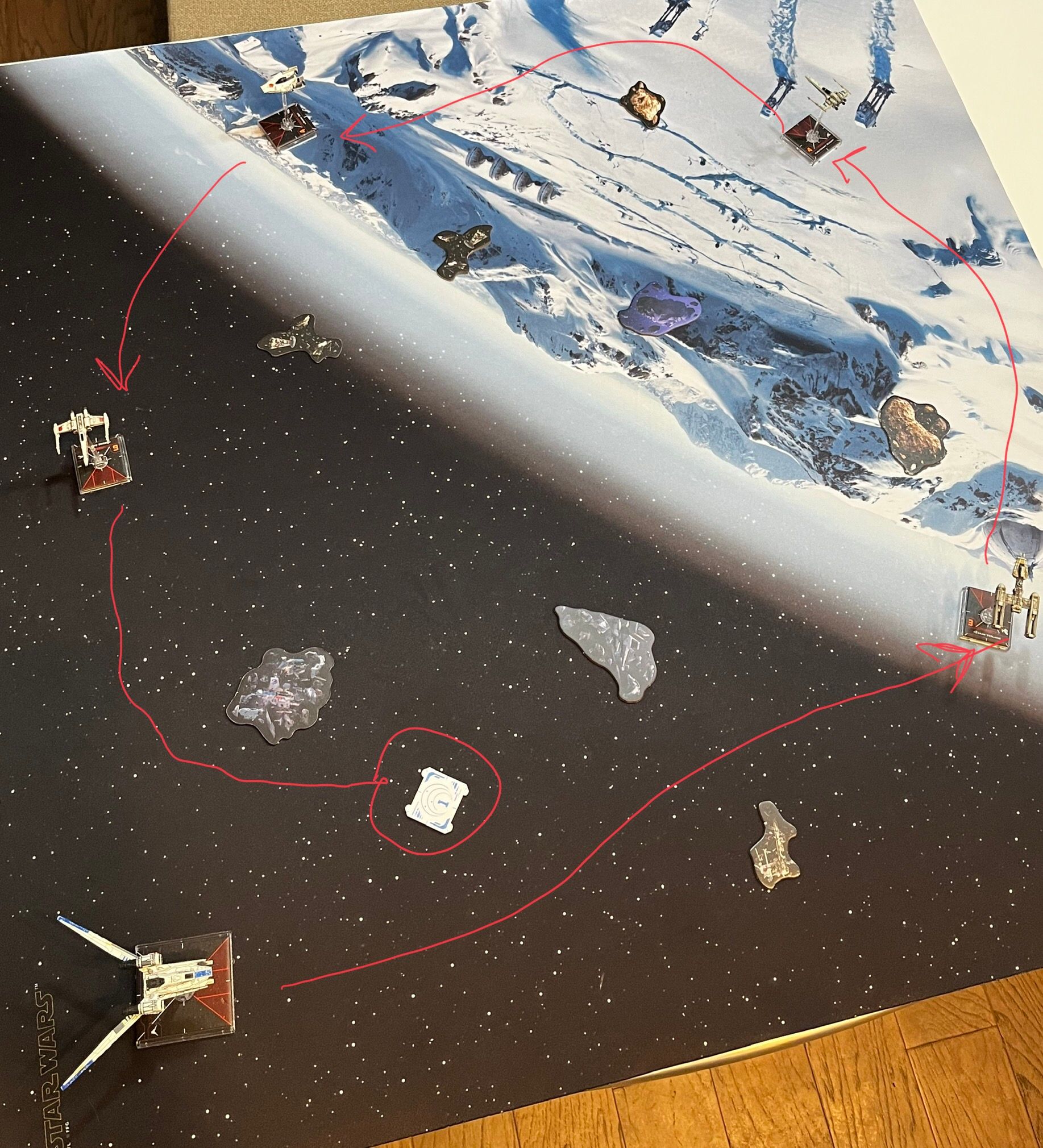
This will be a typical 'round the horn relay race. Set up your ships in evenly spaced locations on the mat with a finish line in one corner. You'll control your ships one at a time in ascending order of initiative. Fly your ship toward the next until you are at range 1. Once at range 1 of your next ship, you must perform a scenario action to "tag" it so that it can begin its leg of the relay. The previous ship can then be removed from the mat. The last ship must fly past the finish line to complete the challenge for your Team. The goal is to finish the course in as few turns as possible. To increase difficulty if desired:
- add obstacles
- ships must overlap to "tag"
Event 4: The Sublight Relays

The second relay event is a simple back and forth relay. Line two of your your ships up in opposite deployment zones of the mat with a randomly placed obstacle field between them. Fly your first ship through the obstacles to cross the opposite board edge within range 2 of the ship on the other side. Once the first ship has left the mat the second can begin its run in the opposite direction. Repeat until all ships have left the mat. The goal is to finish in as few turns as possible. To increase difficulty if desired:
- ships must be at range 1 and/or perform a scenario action to "tag"
- increase obstacles
Event 5: Hyperspace Orienteering
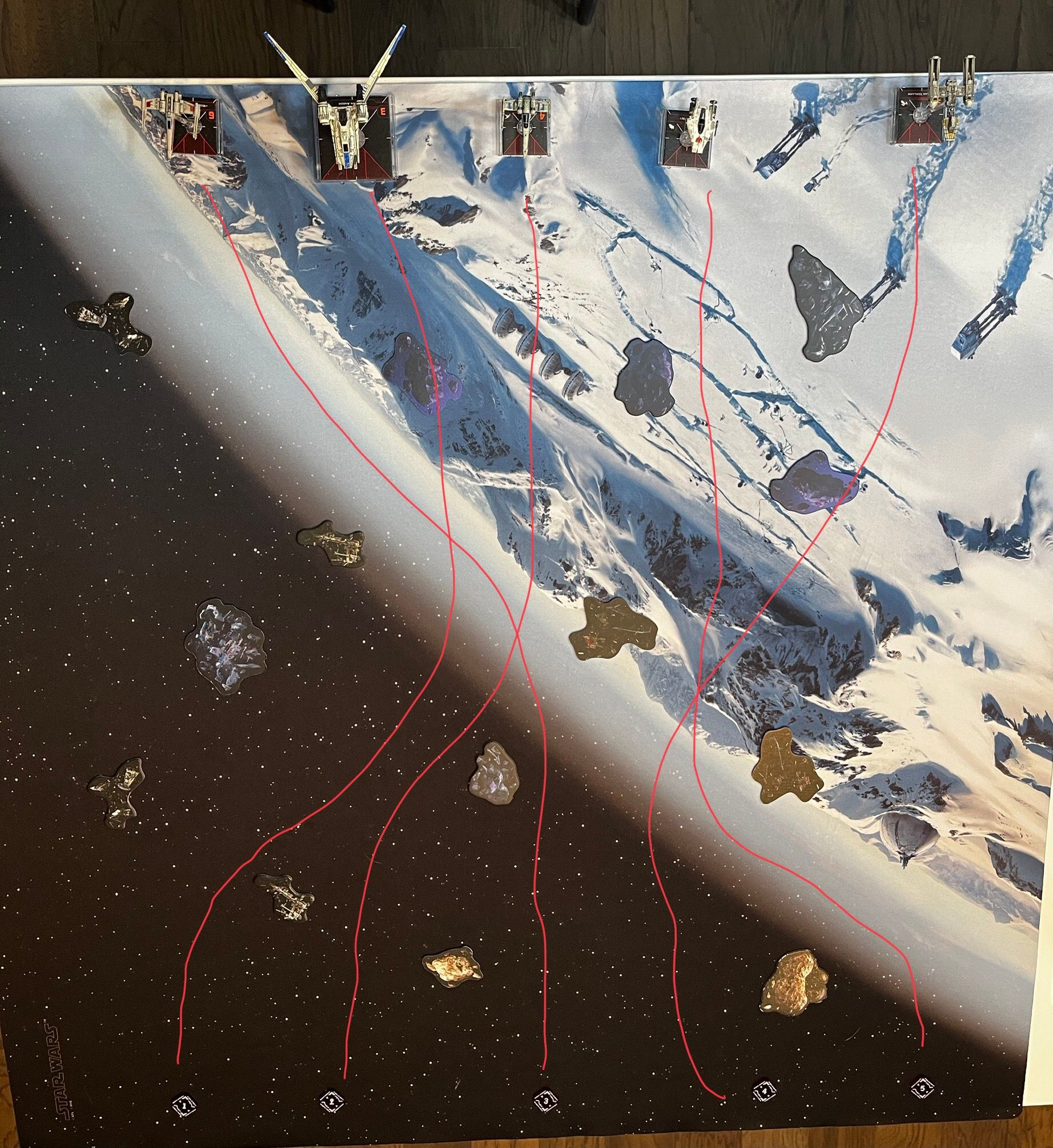
Hyperspace Orienteering is an exercise in "rewinding" your ships to your optimal turn 0 setup. Start with all ships randomly placed touching one edge of the mat. In your deployment area, place a number of markers or tokens equal to the number of ships in your list in locations, either random or corresponding to your planned setup for this list. Fly through the mat and randomly placed obstacles until each ship is at range 1 of its corresponding marker. Once a ship has reached its goal it may stop moving. The goal is to get all ships to their final position in as few turns as possible. To increase difficulty if desired:
- increase obstacles
- set more complex end marker configurations, to include specific numbered positions for each ship
That's my rough outline of a way to have a bit more fun when practicing X-Wing fundamentals! Note that this wont necessarily help with the more combat-oriented parts of the game but can help you get more comfortable with the mechanics of setting dials and predicting and executing your maneuvers. How do you practice when you aren't playing full games?
